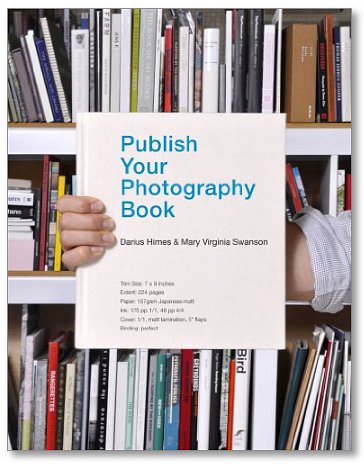Tuesday, May 31, 2011
Will this be any better than Publish Your Photography Book?
After reading a review at Conscientious, I immediately ordered Behind the Zines. The book was released today and Amazon says I'll get it in about a week (right when I'll be in Cincinnati), so expect my own review mid-June and we'll see if it is any more useful than my recent self-publishing acquisition.
Meanwhile, my next post will be about my "Epic Fail" project—where you can follow me as I fail my way to...success? utter despair?
Labels:
Behind the Zines
Monday, May 30, 2011
Scenes from the Montparnasse Cemetery
Serge Gainsbourg
Charles Baudelaire
Jean Anouilh
A young man who died tragically at age 21
Abandoned, in process of being reclaimed by the cemetery
Labels:
cemetary,
grave,
Montparnasse,
Paris
Saturday, May 28, 2011
Thursday, May 26, 2011
Review of "Publish Your Photography Book": pretty, disappointing

Nice things first. The book is beautifully designed and printed. The paper is a joy to touch. The use of white space is refined. The imagery is well chosen. Even the inner inner flaps of the book are lovely. The whole thing could be filled with lorem ipsum and I would still leaf through it with pleasure.
I could be snotty and say "and it may as well have been," but that would be unfair. The content isn't bad, but it just isn't satisfying. It tries to do too much and ends up doing too little.
The book is divided into six sections:
1. The Photography Book Phenomenon
This section reads like a seminar intro. Something to make you excited to have spent your money. This is the golden age of photography, etc. etc. Preaching to the choir. Nothing particularly revelatory or insightful, but it earns the spirit stick for pep.
2. The Nuts and Bolts of Publishing
Promising. A longer chapter that promises to get down to the nitty-gritty. The chapter is subdivided into sections about "evaluating and refining your concept, "Behind the Editorial Door: Understanding How Publishers Work," "Submissions and the Path toward Publication" and so on. Those sections are each subdivided and then sprinkled throughout we have a recurring "Industry Voices" segment where the experts give insight and advice. As an outline, it all makes perfect sense and it sound like exactly the kind of information I want. Sadly, it reads like an outline. Or rather, it's like reading a PowerPoint document of a lecture you wish you could have heard in person. You can't help but feel that the authors (Himes and Swanson) have a wealth of knowledge that has been edited down to smithereens. In the "Behind the Editorial Door" section, for example, the "players" are each introduced —sometimes in a little as three sentences—and then we never get to see them play. Six (yes, Pirandello fans, there really are six!) characters in search of a plot.
3. The Making of Your Book
More subdivisions and even fewer pages. Sections include "Editorial Content," Design Considerations" and "Production Details," each with corresponding "Industry Voices." Once again, actual content is sparse. see also: scanty. meager. suitable for a quick blog post, but not for a $30 book. I expect more from Princeton Architectural Press. Bill Jay and David Hurn's On Being a Photographer has far more specific, usable advice than this new publication.
4. The Marketing of Your Book
Same story. PowerPoint notes for a talk we don't get to hear.
5. Case Studies
My favorite part of the book. In fact, if somebody could please publish a book with nothing but case studies it would be a hit. I ate this part up. I reread it. I love hearing the real stories behind a publication. My only regret is that most of studies are woefully short. They are presented in interview format and they made me feel like the interviewer was walked into a room by a PR rep and told "You have six and half minutes. Have a great interview" (see the Uma Thurman Schweppes ad that is currently playing before all movies in French theaters).
6. Resources, Appendices, and Worksheets
Alec Soth's links page on the Little Brown Mushroom Blog is just one great example of how much useful information is already online. I would have liked this book to delve a bit more and find resources that photographers wanting to break into publishing could actually have a shot at using.
In its worst moments, the book comes across as disingenuous—like a seminar about how you, too, can become a millionaire—or in this case, John Gossage. Some of the "Industry Voices" (e.g. Andrea Danese of Abrams) can barely conceal the fact that the reader of Publish Your Photobook is almost by definition someone that will not be launched into the world of art books via any publishing house of note. That's not to say that you won't be the next success story, but I would rather read a book that keeps it real. I would like to see:
- real numbers. Let's have some case studies that show how much a project cost from start to finish. Sébastien Girard's self-published editions of 500 would be a perfect case study for would-be self-publishers, for example.
- real stats. Why not be real and survey some of the publishing houses given in the appendices. How many books did they put out last year, and of those, how many were of new artists? Who is selling?
- real focus. If this were a student paper, I would recommend a tighter thesis. This book tries to do too much. I would rather read something like: Publish Your Photography Book: 10 Real-World Case Studies (or even 6) and get the useful information from examples that the reader might find relatable than have 6 chapters with the occasional pearl of wisdom.
- real alternatives. "To Be Published or To Self-Publish?" is NOT the question. Hmm. Have a book with Chronicle or make my own? Tough choice. C'mon, people. Who wouldn't like to be published? "Oh, I was going to go with Steidl, but then I decided that Blurb would be the kind of venue that would offer me complete artistic freedom, so I chose that instead." Let's be honest: even many Magnum photographers aren't getting the kind of publications they would like. So why not spend more time talking about the people that break through in less conventional ways. What about artist collectives? What other models of publishing might be viable alternatives to the big name houses?
Tuesday, May 17, 2011
Tristan Des Limbes
I've photographed street art since the '80s and from time to time I still do, if something grabs my attention. This last week, Tristan Des Limbes has managed to blanket Paris with some pretty amazing, clever work. Some artists that have been around for a long time have grown stale and feel like complete sellouts (Misstic—sorry—comes to mind). But Des Limbes is fresh, and in spite of my aversion to overly commercial street art, I want a T-shirt SVP. If you like what you see, check out the Facebook page, say that Marc sent you and that he wants a "Je ne peux pas me calmer" print baaaaaaaad.
Labels:
Paris,
Street Art,
Tistan Des Limbes
Sunday, May 15, 2011
Saturday, May 14, 2011
Friday, May 13, 2011
Tuesday, May 10, 2011
Sunday, May 8, 2011
Saturday, May 7, 2011
A little hommage to Atget...
Something about French storefronts is appealing even when what's on display is not.The shots are from my wanderings today in one of my favorite neighborhoods.
I'm going to force myself to at least post photos more often, even if I don't have time to do real posts. I'm busy making other people do posts right now. Check out what my students are doing on our study abroad blog. These are not photography students with high end equipment, but I've seen some pretty cool stuff in a "photo du jour" thing we've been doing in class. This week they are supposed to do a post inspired by the photographers we just studied: William Klein, William Eggleston, Eugene Atget, or Henri Cartier-Bresson. They've just posted and I have yet to look at them (and do the horrible task of grading), but I'm sure you'll enjoy seeing Paris through their eyes.
I'm going to force myself to at least post photos more often, even if I don't have time to do real posts. I'm busy making other people do posts right now. Check out what my students are doing on our study abroad blog. These are not photography students with high end equipment, but I've seen some pretty cool stuff in a "photo du jour" thing we've been doing in class. This week they are supposed to do a post inspired by the photographers we just studied: William Klein, William Eggleston, Eugene Atget, or Henri Cartier-Bresson. They've just posted and I have yet to look at them (and do the horrible task of grading), but I'm sure you'll enjoy seeing Paris through their eyes.
Labels:
Paris,
storefront
Monday, May 2, 2011
Sunday, May 1, 2011
Paris May 1 Demonstrations (part 1)
Every year for the Fête du travail the French have a manif (i.e. a May Day march). I'm posting this at 2 a.m. here in Paris, so I won't be writing commentary. Here are a small selection of photos:
Labels:
May 1,
Paris,
Street Photography
Subscribe to:
Posts (Atom)


















































